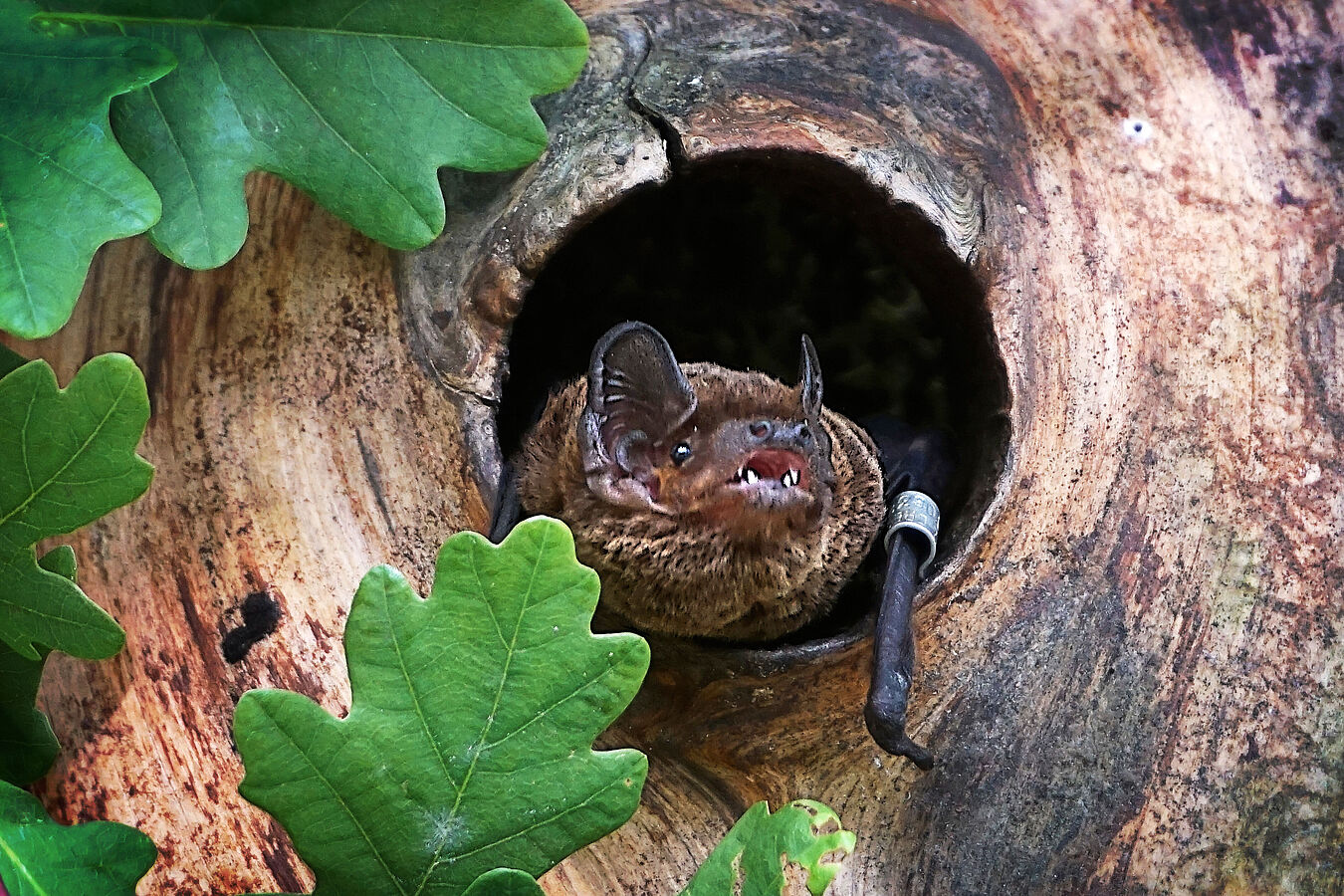Many bat species native to Germany, such as the Leisler's bat, are forest specialists.

Leisler's bat at a treehole in an old oak tree | Photo: Carolin Scholz
However, as it is becoming increasingly hard for them to find tree hollows in forest plantations, so they are moving to settlements instead. Using high-resolution GPS data from bats, a team led by scientists from the Leibniz Institute for Zoo and Wildlife Research (Leibniz-IZW) has analysed in greater detail than ever before how Leisler's bats use their habitats, which tree species they look for when searching a roost, and which forest types they avoid. They found that these bats increasingly seek refuge in old trees in urban areas and in old buildings such as churches. In an article published in the "Journal of Environmental Management", the team calls for stronger efforts to preserve these alternative roosts in settlements, as well as for ecologically sustainable forestry that protects old trees and promotes structurally rich forests.
With more than 1,400 species worldwide, bats are an enormously species-rich group of mammals. Many native species in Germany and Central Europe, such as the Leisler's bat (Nyctalus leisleri), are classic forest dwellers that depend on tree hollows and structurally rich forests. In their study, the research team demonstrates how today's forestry is altering the habitat of these animals and highlights the importance of targeted measures to preserve their roosts. Leisler's bats are increasingly having to switch to daytime roosts in villages, as old trees with suitable cavities for roosting are getting rarer in forest plantations. They therefore seek shelter in the walls of old village churches and in old trees in residential areas, parks, and along lanes.
European forests have been intensively managed for a long time, which has had a detrimental effect on many specialised species, such as Leisler's bats. Professor Christian Voigt, from the Leibniz-IZW and the University of Potsdam, explains the new study in the east of Germany: 'We wanted to know how Leisler's bats, which are typical forest dwellers, respond to the intensification of forest management. This European species of bat is dependent on diverse deciduous forests with many old trees bearing woodpecker holes. This kind of habitat has become hard to find in the monotonous pine plantations of the study area." Although Leisler's bats are relatively abundant in Germany, their exact population size is unknown.
Oak forests favoured - spruce forests avoided: first detailed insights into the habitat use of the Leisler's bat
For the study, the team fitted 32 adult Leisler's bats in the German state of Brandenburg with miniature GPS loggers. These loggers generated detailed movement data, describing where the bats forage, where they rest during the day and which corridors they use for commuting. "Thanks to the high resolution of bat movement data, we were able to compare these with high-resolution landscape data for the first time, enabling us to carry out analyses at the level of individual forest tree species and small-scale structures such as copses, hedges or rows of trees," explains wildlife biologist Dr Carolin Scholz from the Leibniz-IZW. 'Such detailed insight into the habitat selection of the Leisler's bat was previously unavailable. However, this information is crucial to better consider the ecological requirements of the species in the future.'
The team's analysis clearly shows that Leisler's bats favour structurally rich oak forests as a habitat, while certain coniferous forests including those dominated by spruce forests were largely avoided. Old trees, especially oaks, are a key habitat for Leisler's bats. Interestingly, the data also shows that Leisler's bats regularly roost in residential areas. Bat expert Dipl.-Biol. Uwe Hoffmeister from the natura Büro für zoologische und botanische Fachgutachten (office for zoological and botanical consulting) explains: "With the help of GPS telemetry, we were able to show that, Leisler's bats are increasingly exploring village centres and historic buildings such as churches, although they prefer forests as their natural habitat. We suspect that this is a response to the lack of suitable daytime roosts in managed forests - Leisler's bats are probably forced to switch to alternative habitats in settlements because they have lost their original roosts in the forest."
Sustainable forestry and preservation of old trees also necessary in residential areas
According to the authors, it is key to protect alternative roosting sites for bats and to develop an ecologically sustainable forestry practice that promotes old trees and structurally rich deciduous and mixed forests. According to the authors, this is the only way that forest bats such as the Leisler's bat can survive in managed forests in the long term. Measures such as targeted, careful timber extraction and longer growth periods before harvesting can significantly increase structural diversity without fundamentally jeopardising the economic benefits of forestry. Furthermore, urban green spaces should be recognised as refuges for wildlife, such as bats. "Old and hollow-rich trees should be protected not only in forest plantations, but also in urban areas for species such as the Leisler's bats", concludes Voigt.
Wind turbines in the forest as an additional threat
As Leisler's bats are frequently die at wind turbines, expanding the use of wind energy in forests could negatively impact this species' population growth. Wind turbines even appear to attract Leisler's bats. Voigt explains: 'At dusk, the bats may mistake the turbines' silhouettes for large trees and fly towards them in search of roosts. The risk of collision could increase notably, as the bats fly at a height at which the turbines' rotor blades spin." It is therefore urgent that we consider the habitat requirements and the movement behaviour of this highly mobile species. This study provides data that will enable foresters, landscape ecologists, and nature conservation authorities to implement effective protection measures for the bats. For example, new wind turbines should not be erected near structurally rich deciduous forests or next to bat roosts.
Scholz C, Grabow M, Reusch C, Korn M, Hoffmeister U, Voigt CC (2025):
Journal of Environmental Management, Volume 387, July 2025, 125753.
DOI: 10.1016/j.jenvman.2025.125753






